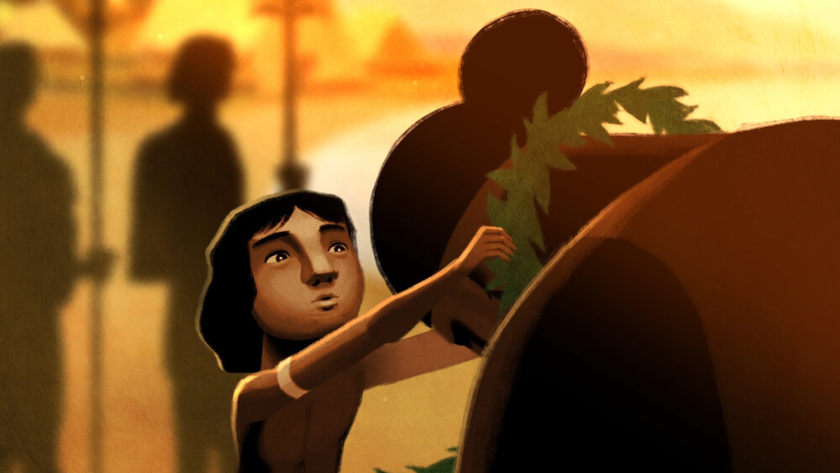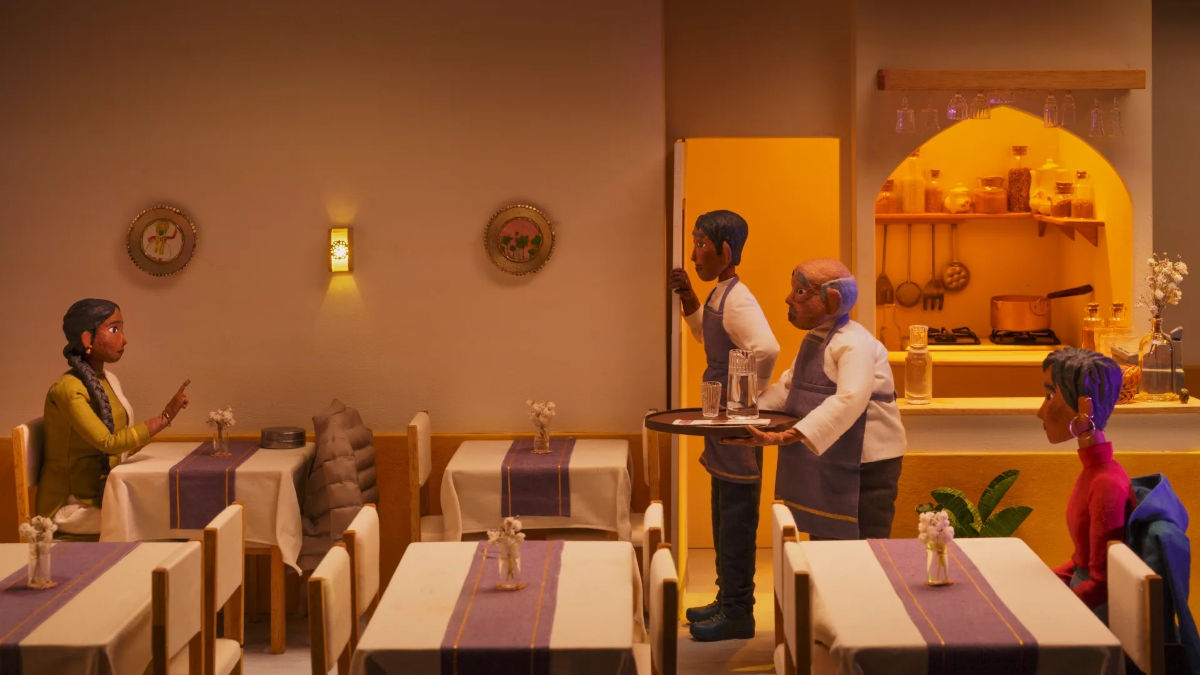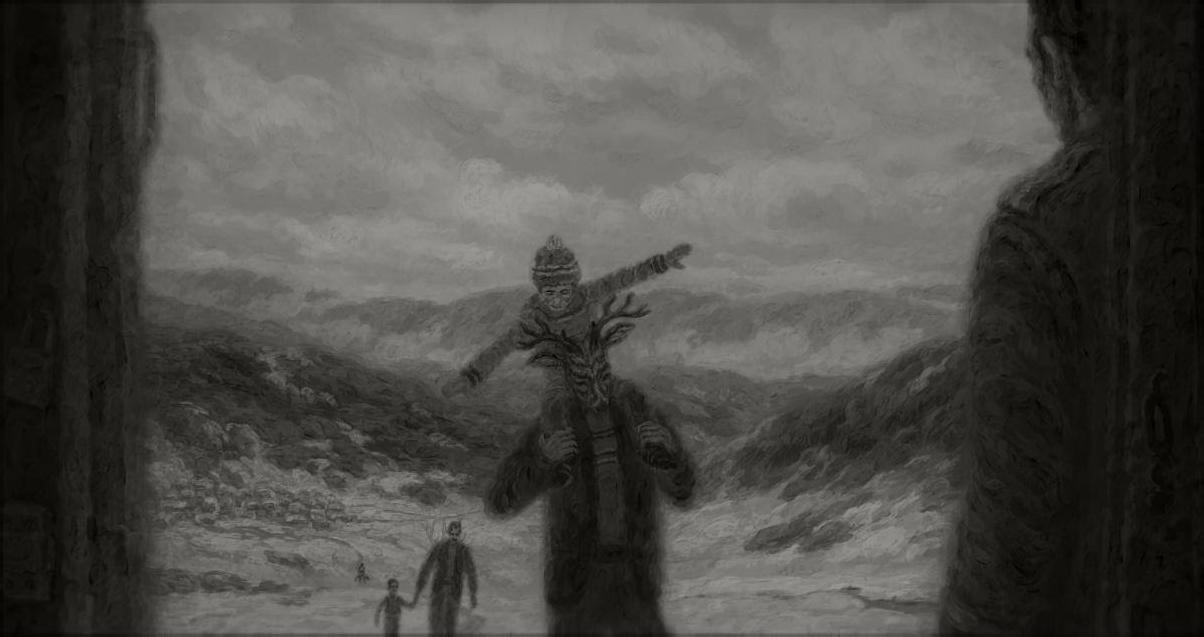Kapaemahu by Hinaleimoana Wong-Kalu, Dean Hamer and Joe Wilson

It is one of those animation shorts which bring you back in time, and connect the past with the present. Kapaemahu animation short is co-directed by Hinaleimoana Wong-Kalu, Dean Hamer and Joe Wilson -and involving Daniel Sousa (Oscar-nominated for Feral) as an animation director.
Long ago, four extraordinary individuals of dual male and female spirit brought the healing arts from Tahiti to Hawaii. The name of their leader was Kapaemahu. Beloved by the people for their gentle ways and miraculous cures, they imbued four giant boulders with their powers. The stones still stand on what is now Waikiki Beach, but the true story behind them has been hidden – until now- Film Synopsis
Zippy Frames talked with the whole Kapaemahu team:
ZF: What was the need to make the film Kapaemahu? Is it a contemporary celebration of a monument not really appreciated? Is the need to finally get some part of oral history written down?
HWK: I’ve known about the stones of Kapaemahu since I was a young boy playing in Waikiki, but it was only when I transitioned to become Hinaleimoana, a strong and confident woman, and began to immerse myself in Hawaiian culture and language that I realized how they relate to me personally, and at the same time embody a beautiful part of our Hawaiian culture that most people know nothing about.
Such stories are rarely told, and when they are, it’s usually by outsiders who impose their lens of the world, their language and culture, to synthesize and process the narrative through their own experience. I wanted to tell the story from my perspective as a native mahu wahine and to tell it in the language that my ancestors might have used to pass it on.
I was fortunate that Dean Hamer and Joe Wilson, two filmmakers whom I first met when they made a documentary about my work as a teacher, shared my interest. Over the past decade, we’ve collaborated on a series of Pacific Islander films, from Tonga to Samoa to Tahiti, and I knew I could trust them to stay true to the Polynesian heart and soul of the story.
Watch Kapaemahu
JW: I first heard about the stones when we were filming Hina for the documentary one day in Waikiki. The more I learned about the history behind them, and what the erasure of the history of that monument has meant for Hina and so many others, the more I felt it was essential to support her efforts to bring the story of the stones, and the healers whose spiritual essence they hold, back to life.
As we were working, the importance of the project continued to grow, particularly as the debate on the meaning of monuments and the lessons of history began to roil the nation. While most of the attention has been on the long overdue removal of statues that honor racist and imperialist figures from our ignoble past, the story of Kapaemahu is focused on lifting up a monument dedicated to some of history’s heroes and making sure that Hawaiians, and the world, know the full story of their identities. It’s a project that has many components, flowing from the animated short, that can really make a long term difference.
ZF: Did you choose a most prominent version of the story and proceeded with that to write the script? Or did you cherry pick from many different story elements to create your own presentation?
DH: We spent over five years researching the tradition of Kapaemahu before even starting the script. The breakthrough was the discovery of the original handwritten manuscript of the story, which had been recorded a century ago by a Hawaiian member of the noble class who may have heard it from the last queen of the Hawaiian Kingdom. Our script followed the manuscript closely because we felt the original story was so powerful that it didn’t need any embellishments or revisions. We were also sensitive to the fact that many modern interpreters had altered the story to try and minimize the role of gender diversity; one tourism promoter even made the bizarre claim that the name Kapaemahu – which literally means “the row of mahu” – should be interpreted as “non-homosexual.” Given that sort of manipulation and censorship, we felt it was important to stick to the version of the story passed down by the elders.
ZF: The animated short format binds you to a very short time length, compared to a short or long form documentary. Was that a hindrance or perhaps worked to your advantage?
JW: There are some Hawaiian stories that take days or months to tell in their fullness, others that can be recounted through a single hula. Kapaemahu happens to be one of the latter and it was this particular short story that Hina felt most important to tell. As you suggest, this was actually quite fortunate, from a producers’ point of view, given the amount of time and creative resources it takes to produce even just an eight-minute animated short.
ZF: How easy was to get funding for the film? You already have as a team a track record of documentaries in your slate, but this was your first animated endeavor.
DH: We were fortunate that our funder, Pacific Islanders in Communications, has a deep knowledge of Pacific storytelling traditions, and immediately recognized Kapaemahu as a moolelo – a Hawaiian term for stories that blur the conventional boundary between myth and history, narrative and documentary, fiction and nonfiction. This is why they were willing to support an animated short film as well as a documentary about this topic, which is currently in-production, even though that’s unusual for a public broadcasting system funder in our country; they recognized that it was the most fitting format to tell this particular story.
ZF: The animation is fluid and symbolic at the same time. I was wondering, apart from the specific research made on character design etc, what kind of challenges this project created, like capturing all spectacular Hawaii sunrises and sunsets. How was the collaboration between the animation director and the directors?
DS: We looked at a lot of Polynesian visual references that informed the design and palette of the film, from the colors and shapes in traditional Tapa cloth and lau hala weaving to landscapes, architecture, flora, clothing and people. The main concern for character design was to present the mahu as stately and dignified individuals, as befits their high position, and in no way stereotyped or cartoonish.
The most challenging aspect of this film, aside from the sheer amount of work that is involved with any animation project, was making it feel consistent and organic from start to finish. We created an entire world from the ground up, and stylistic decisions like character designs and color palettes, all the way to overall pacing, shot progressions, and the flow of the storytelling all had to be carefully balanced.
We started with Hina’s script, and from there I created a storyboard and an animatic, while simultaneously generated character and background designs, as well as style frames for each critical moment in the story. This combination of animatic and style frames became our template for shaping the film. The directors were involved from start to finish and offered notes and references along the way by regular video conferences.
Watch the Making of Kapaemahu film
ZF: The film is stating the Māhū tradition, but does not argue or try to defend an LGBTQIA status, it accepts a third gender as a reality -before moving on to the story of healing itself. Was that the way you wanted it to be portrayed? I know you've already talked about this in your other films, so perhaps Kapaemahu is not about Māhū per se, but the story that these people make?
HWK: Yes, that's exactly right. When the story was originally told, the fact that the healers are mahu would have been understood as simply one aspect of their nature; an important and beneficial characteristic, not a diminishing one. Just as important, they were beloved by the Hawaiian people for the their talents and skills as healers and their willingness to share their spiritual wisdom. That is their enduring legacy.
The issue of gender only became prominent when Westerners, who had very rigid, binary views dictated by religion, felt the need to suppress Hawaiians' more fluid and accepting understanding. Although I don't frame the story in this kind of LGBTQIA terminology, because that's not my cultural grounding, I do hope it resonates with queer people everywhere who know what it's like to not see yourself reflected in your own society. No matter where we live or who we are, we all need to feel seen, included and valued for the contributions we make.
ZF: I know the film has been successful in many international festivals, including Tribeca Film Festival, Annecy Festival etc. I would like to know if you had any feedback from its screening that stayed with you. Has Kapaemahu been screened in Hawaii as well?
JW: Of course, it’s been a huge disappointment to be invited to so many wonderful festivals yet, because of the pandemic, not be able to attend. In fact, we still haven’t had the opportunity to watch the film on a big screen with a live audience. But, the virtual festival landscape has resulted in the film reaching many, many more viewers, and one particularly pleasant surprise has been its popularity with young people. I think the award we’re most proud of is from the Chicago International Children’s Film Festival Children’s Jury, comprised of film fans aged 6 to 12.
What’s interesting about this is that we usually think of gender diversity as a topic for adult audiences, but for kids it’s totally natural. Being somewhere in the middle of male and female on the gender spectrum is special and wonderful – not something to worry about or be ashamed of.
DH: We were able to screen Kapaemahu here at home at the Hawaii International Film Festival this fall, and it was a big hit. But what we’re really excited about is making the film available to the millions and millions of locals and visitors who normally stroll by this stone monument every year. In addition to PBS broadcast, this will include a major exhibition at the Bishop Museum, in-room TV programming in Waikiki hotel rooms, in-flight entertainment on airlines serving Hawaii, and live hula and film events near the stones’ home on one of the most popular stretches of Waikiki Beach.

ZF: Do you plan to make more animated films? Kapaemahu has a narrative arc that could lead into a feature film itself -if you want it so.
TEAM: This is our first fully animated film but it definitely won’t be our last. It’s such a powerful medium – the perfect 21 st century digital continuation of storytelling traditions in Hawaii and the Pacific. We have several projects in mind, including a feature based on the saga of Pele the fire goddess and her tempestuous relationship with Kamapuaa the pig god. Right now we’re working with three wonderful young women animators in Hawaii on a short based on the legend of Kapo Maʻi Lele – a story of female empowerment that we expect will cause quite a stir.
(HWK – Hinaleimoana Wong-Kalu, JW – Joe Wilson, DH – Dean Hamer, DS – Daniel Sousa)
Film Review (Vassilis Kroustallis):
Kapaemahu is one of those happy, calculated accidents in independent animation where synthesis matters. Far from being a sole auteurist film, it gives the impression that all creative spirits, from the storyteller and narrator (Hinaleimoana Wong-Kalu) to its co-directors and animation director and chant composer, want and succeed to tell the same story in a unified and multiply enriched way. This holistic procedure, itself reflected in the 4 main healers -now monument rocks with healing powers- gives the film a breathing space that outlasts its length. Overturning binary stereotypes, and securely routed in the Hawaiian tradition (the Olelu Niihau Hawaiian dialect spoken is only one of film's advantages), Kapaemahu takes the time to investigate our own relationship with the past and its oral history; if only to offer a continuation with the future through the eyes of a child. The animation sets the tone of both symbolic and fluid figures, ready to communicate their translucent powers, in a setting whose hues definitely invite inclusiveness instead of pre-defined background spaces. Kapaemahu is a thoughtful film about connecting the past to the future, inviting understanding, and executed in a uniquely empathetic way. A must see.
CREDITS
Kapaemahu (8' 28'', 2020)
Written,Directed and Produced by Hinaleimoana Wong-Kalu, Dean Hamer, Joe Wilson | Animation Director: DanielSousa |Sound and Music: Dan Golden | Chant Composer and Chanter: Kaumakaiwa Kanakaole | Narrator: Hinaleimoana Wong-Kalu | Chant Sound Producer: Shawn Pimental | Sound Mix: Phil Perkins | Executive Director for PIC: Leanne Ferrer
Kapaemahu is a co-production of KanakaPakipika with Pacific Islanders in Communications, with funding from the Corporation for Public Broadcasting
About the Kapaemahu Team
Hinaleimoana Wong-Kalu / Director, Producer, Narrator: She is a Native Hawaiian teacher, cultural practitioner and filmmaker who uses digital media to protect and perpetuate indigenous languages and traditions. She began her film work as a protagonist and educational advisor for the award winning films Kumu Hina and A Place in the Middle, and received a National Education Association Human Rights Award, Native Hawaiian Educator of the year and White House Champion of Change Award for the groundbreaking impact campaigns associated with those films. Continuing her journey to the other side of the lens, Kumu Hina produced the PBS/ARTE feature documentary Leitis in Waiting and award-winning short Lady Eva about her transgender sisters in the Kingdom of Tonga. Hina is also a transgender health advocate, burial council chair, candidate for the Board of Trustees of the Office of Hawaiian Affairs, and composer of “Ku Haaheo E Kuu Hawaii,” the internationally-known anthem for the protection of Mauna Kea which was honored as Hawaiian Song of the Year in the 2020 Na Hoku Hanohano Awards, known as the Hawaiian Grammys.
Dean Hamer / Director, Producer: He is a New York Times Book of the Year author, Emmy and GLAAD Media award-winning filmmaker, and National Institutes of Health scientist emeritus with a long history in communicating complex and controversial ideas to diverse publics. He formed Kanaka Pakipika with partner Joe Wilson and documentary film protagonist Hinaleimoana Wong-Kalu to collaborate on an insightful series of films that have opened the eyes of the worlds to the lessons to be learned from Polynesia’s unique approach to diversity and inclusion. He is currently working on a book and museum exhibition based on Kapaemahu. Hamer is the author of several best-selling nonfiction books including “The Science of Desire” and “The God Gene,”has been a consultant for the BBC and Discovery channels, and his research has been featured in Time, Newsweek, and Science magazines and on Frontline and Oprah.
Joe Wilson / Director, Producer: He is an Emmy Award-winning filmmaker dedicated to telling stories that emanate from the voices of those on the outside. His feature and short films combine live action with animation to explore pressing social issues through innovative storytelling. Wilson’s work has screened and won awards at festivals around the world including Berlin, Toronto and Tribeca, been viewed by millions of viewers on PBS, ARTE and other international broadcasts, and has been supported by Sundance, Ford and the Corporation for Public Broadcasting. Wilson's 2010 film Out in the Silence focused on the challenges of LGBT people in rural and small town America and became the centerpiece of a multi-year national campaign to open dialogue and build bridges across socio-political divides. Shortly after, he and partner Dean Hamer began their now decade-long collaboration with Hinaleimoana Wong-Kalu, first documenting her story in the PBS Independent Lens Audience Award-winner Kumu Hina, then with Hina joining as producer on a series of films about gender diversity in the Pacific, including Leitis in Waiting, Lady Eva, and The Rogers. Kapaemahu is Wilson’s fifth film in collaboration with Hina. Prior to filmmaking, he served as Director of Human Rights at the Public Welfare Foundation and Producer of Pacifica Radio's Democracy Now.
Daniel Sousa / Animation Director: He is an Academy Award-nominated animator who uses the themes embedded in myths and legends to examine archetypes of human nature. Born in Cape Verde, he approaches filmmaking from a painter’s perspective, focusing on the fragility of fleeting moments, memories and perceptions. His short films include Feral, which was supported by a Creative Capital Foundation grant and screened at Sundance, and Fable, which won awards at festivals around the world. He recently completed animating several native legends for the four-part PBS special Native America, which weaves history and science with living indigenous traditions. Sousa has taught at the Rhode Island School of Design, Harvard University, The Museum School, The Art Institute of Boston and the Animation Workshop in Denmark.










